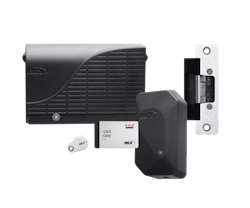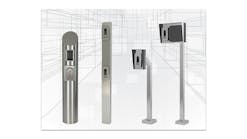Battery-Operated Convenience For Electric Strike & Card Reader Applications
Electric strikes have always required external power because the current draw of the solenoid has far outweighed the ability of batteries to provide sufficient power for repeated use. Now DORMA has solved this problem with its Low-Power Prox (LPP) Access Control System Kit from their Rutherford Controls International affiliate. The LPP proximity reader and electric strike are powered by two 9Volt alkaline batteries, providing up to 40,000 operations per set of batteries. The LPP uses low frequency 125kHz proximity cards or fobs that are standard for all HID Proximity access credentials using 26 Bit.
The Low-Power Prox Electric Strike System is a niche lock system, designed for remote applications or applications where running power is not practical. This battery powered system provides a higher level of access control, enabling existing employee proximity badges to be programmed to the LPP, eliminating the need for extra credentials.
The kit contains a proximity card reader, two programming cards, two proximity cards, two shadow cards, main power controller, and an electric strike. The proximity card reader is 1-11/16" wide by 3" tall. The wiring harness from the reader to the controller is about 36". A removable 9Volt battery plug can provide emergency power if the batteries have lost power. The wiring harness from the controller to the electric strike is approximately the same length.
The main power controller, which is mounted onto the secured side of the door, is 4-1/4" tall by 2-7/8" wide by 7/8" deep. Two six-wire connectors plug into the wiring harness. Batteries are contained within the power controller.
Up to 250 proximity cards/fobs can be programmed to the DORMA Low-Power Prox Access Control System. The card/ fob reader read range is approximately one inch. When a programmed credential is presented, the electric strike will unlock for five seconds.
There are six electric strike options for the LPP (see sidebar for details). Each of the 12VDC electric strikes has 1500-pound holding force, is UL/CUL listed** , with non-handed bodies and stainless steel finishes. Because the kit is designed for battery operation, the electric strikes must be configured to Fail Secure operation.
The battery power makes the DORMA LPP Access Control System Kit a good choice for a remote location without access to electricity. The battery powered LPP card reader and controller can operate as a standalone system or can be integrated to operate using most existing 125kHz 26 bit proximity credentials.
Installation
Installation of the LPP Access Control System Kit is straightforward. Depending upon the lock hardware and the door/frame configuration, the electric strike option is chosen.
The proximity card reader is narrow, which means it can be installed onto the lock side of the frame or onto the face of a mullion for a two-door application. Installation of the electric strike varies depending configuration. Note: Use the surface mounted ES62F electric strike for installing the LPP system onto a fire rated opening equipped with a rim exit device.
Programming
The Low-Power Prox is a standalone system that is programmed at the reader. To program user proximity cards or fobs, use the ADD programming card and the DELETE programming card to place the LPP operating system in the ADD card mode or the DELETE card mode.
The LPP requires the use of a shadow card in order to program a user card. The shadow card provides the ability to invalidate an existing user's card or fob without having access to the card itself. To invalidate the user's card, present the delete card to enter the delete mode. Present the user's card, fob or Shadow card to be deleted. To re-validate a user's proximity card, present the ADD programming card and the user card or fob.
Suggestion: Write the user’s name or an acronym on each shadow card in order to identify it if necessary to delete the user.
Programming User Cards:
Step 1. Present the ADD card to the reader. A single LED flash and a beep indicate the LPP operating system is in the ADD mode.
Step 2. Within a few seconds, present the user card to be added. Once the card has been added, the reader will emit a single LED flash and beep, indicating the user card has been programmed.
Step 3. Within a few seconds, present the shadow card to be added. Once the card has been added, the reader will emit a double LED flash and beep, indicating the shadow card has been programmed.
Steps 2-3 can be repeated to add multiple user card/shadow cards.
To return to operating mode, wait 10 seconds and a double LED flash and beep will occur to indicate the controller is back in the operating mode.
Deleting User Cards:
Step 1. Present the DELETE card to the reader. A double LED flash and a beep will indicate the LPP operating system is in the DELETE mode.
Step 2. Within a few seconds, present the user card OR shadow card to be deleted. Once the card has been added, the reader will emit a single LED flash and beep indicating the user card has been deleted.
Step 3. Repeat step 2 to delete additional user cards.
To return to operating mode, wait 10 seconds and a double LED flash and beep will indicate the controller is back in the operating mode.
To gain access, a programmed 125kHz 26 bit proximity user card or fob is presented to the reader. The reader's LED will flash green and beep, indicating access is granted. After five second, the electric strike will relock.
The Low-Power Prox System can have up to 40,000 operations on two 9Volt batteries. There is a low battery warning. The reader LED remains illuminated when approximately 250 operations are still available on one battery and 500 operations for two batteries. An emergency battery connector is built into wiring harness at the reader end. To operate the LPP if the batteries fail, remove the reader and attach a 9Volt battery to the connector.
An advantage of battery power is in the event of power loss, memory is maintained and the system will remain operable. However, the LPP System can be hardwired using the emergency battery connection in the wiring harness to run a 12VDC power.
Important: The electric strike can be field configured for Fail Safe operation, requiring continuous power to remain locked. However, under battery power, the LPP must be configured Fail Secure, requiring power only to unlock.
The Low-Power Prox System comes with a two year limited warranty.
For more information, contact your local locksmith distributor or DORMA USA, Inc., Dorma Drive, Drawer AC, Reamstown, PA 17567. Telephone: 800-523-8483. Web Site: dorma.com/us/en.
**Only the Fire-rated strikes are cULus rated. The others are UL rated only.
LPP Kit Contents
- 1 Proximity card reader
- 2 Programming cards
- 2 Proximity cards
- 2 Shadow cards
- Main power controller
- Electric strike
Electric Strike Options
DORMA ES62 and ES62F surface-mounted electric strikes. These non-handed electric strikes are designed for rim exit devices with latch projections of ½" to ¾". The surface-mounted strikes do not require cutting into the frame. The E62F option has a 3-hour fire rating.
DORMA ES84 centerline latch entry electric strike. The ES84 accepts 1/2" or 5/8" latch projection, having a 1,500-pound holding force and a ¼" horizontal adjustment. The electric strike is field selectable Fail Secure or Fail Safe with the turn of a dial. The low profile ES84 has a 1-1/16" frame depth.This allows the strike to accept a ¾” latch.
DORMA ES86 centerline latch entry electric strike. This strike is functionally the same as the ES84; however, the ES86 has a 1-3/16" frame depth.
The ES84 and the ES86 kits come with three stainless steel (630) faceplates; a 1-1/4" × 4-7/8" ANSI square corner for hollow metal frames, a 1-7/16" × 7-15/16" ANSI round corner for aluminum or wood frames and 1-1/4" × 4-7/8" ANSI round corner aluminum frames. The ES84 electric strike is available with the latch/keeper monitor switch (LKM).
DORMA ES96F and the ES96F 96LM electric strikes. These strikes have a keeper opening in excess of 3 inches to accommodate centerline and offset latchbolts in cylindrical and mortise locks. They have an adjustable dead bolt keeper and deadlatch ramp to accommodate a variety of mortise locks with offset latches. In addition, there is a faceplate for centerline latch entry. The plug-in 96LM (Latch Monitor) switch option can be ordered with the ES96F 96LM electric strike or field installed.






